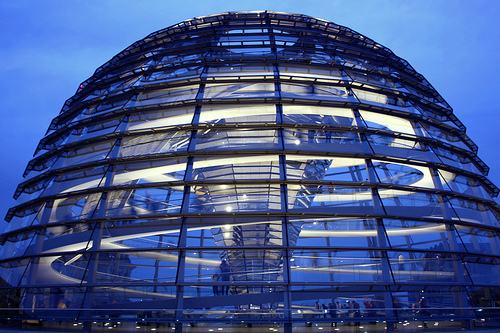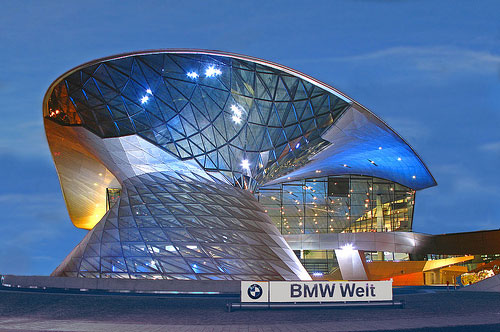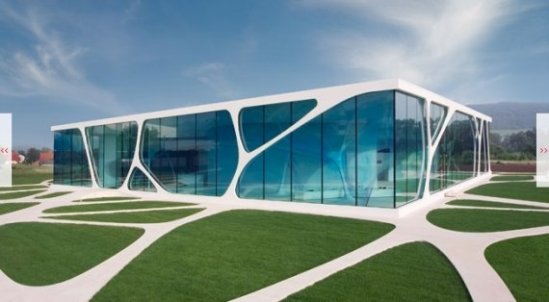Eventually I’m going to blog about something I actually know about, but until then, there’s German architecture. Somewhere between wanting to be a film director, an internet entrepreneur, a best-selling novelist and a circus promoter, there was a lonely period of about three months during my first year of college when I actually thought I would one day be an architect.
The Kunstmuseum Stuttgartis a contemporary and modern art museum built and opened in 2005. The cubic museum building with 5000 m² of display space was designed by Berlin architects Hascher and Jehle. Among locals it is affectionately called, “The Glass Cube.”
———————————-
However, after being so completely intimidated by the first major project assignment, I couldn’t drop out of that class fast enough! Today I’m still not sure if it was more a lack of confidence or just pure immaturity.
Stuttgart is home to the Mercedes-Benz brand and the international headquarters of Daimler AG. The current building, which stands directly outside the main gate of the Daimler factory in Stuttgart, was designed by UN Studio. It is based on a unique cloverleaf concept using three overlapping circles with the center removed to form a triangular atrium. The building was completed and opened on May 19, 2006. — Excerpt via Wikipedia
———————————-
Still, appreciating the architecture of Germany is somewhat of a pleasurable sport. Whether it is from the Roman period, Classical, Medieval, Baroque or Gothic I must admit I find it quite interesting in deep contrast to the abundance of more modern designed structures in Southern California, where an “old building” is, at its best, one built sometime during the early 20th century
This residence is located about five minutes from my apartment in Marbach, so I pass it nearly every day on the train ride home. It truly makes a bold statement within our small, quiet town lying on the Neckar River. Designed by the Juergen Mayer H., Simon Takasaki, Andre Santer, Sebastian Finckh Team, it was originally built in 1984.
——————————-
I like discovering that a building’s exterior can often times surprise me in that these old, unassuming offices and apartments can be so different once you’ve stepped inside. To a Euro newbie like me I would not expect modern wood flooring, high-tech lighting and such contemporary interior design to be housed in such old looking structures – it was an interesting dichotomy.
The Fernsehturm Stuttgart is the world’s first TV tower built from concrete (and prototype for many towers of that kind all over the world). Although controversial at first, it quickly became a well known landmark of Stuttgart and tourist attraction. From the two observation decks there is a view of Stuttgart, from the forests and vineyards in and around Stuttgart to the Swabian Jura and the Black Forest.
———————————
This gradual presence of modern architecture has seemed to have caught my attention a bit more these days. While I’ve often complained about the dull colored buildings and apartments here in Germany, nonetheless I appreciate these sudden ultra-modern structures sprinkled throughout city neighborhoods in Baden Württemberg. It sends a message, welcomed or not, that change has come and innovation is in the air.
The current Reichstag dome is a glass dome constructed on top of the rebuilt Reichstag Building in Berlin. It was designed by British architect Norman Foster and built to symbolize the reunification of Germany. The distinctive appearance of the dome has made it a prominent landmark in Berlin with a 360 degree view of the surrounding Berlin cityscape. — Excerpt via Wikipedia
——————————-
The House of World Cultures is Germany’s national centre for contemporary non-European art. It presents art exhibitions, theatre, and dance performances, concerts, author readings, films and academic conferences on non-European Visual Art and culture.
——————————–
Berlin design team, Sauerbruch Hutton took first prize in an international competition to design the new home for Hamburg’s Behörde für Stadtentwicklung und Umwelt/BSU (Office for Urban Development and Environment). The new BSU building will be erected in Hamburg Wilhelmsburg and is slated for completion in 2013. The contemporary energy-efficient facility will include open exhibition space, a library and a selection of restaurants.
—————————————
A Munich landmark, which has been serving as world headquarters for the Bavarian automaker for almost 40 years. It was declared a protected historic building in 1999 built between 1968 and 1972 and was ready just in time for 1972 Summer Olympics. The large cathedral exterior is supposed to mimic the shape of a tire in a race car. Designed by Austrian architect, Karl Schwanzer.
———————————-
Designed by the German firm “3deluxe” this futuristic building is the headquarters for the German glass manufacturer and gift-ware company, Glaskoch. The structure was named after their main brand, “Leonardo”.
———————————–
The Neue Staatsgalerie was designed by the British design team of James Stirling, Michael Wilford and Associates although largely credited to James Stirling (1926-92) and is considered one of his most important pieces of work. Constructed in the 1970s and opened to the public in 1984. The building has been claimed as the epitome of Post-modernism.













Reblogged this on The White Tiger's Page.
Pingback: Appreciating Modern and Distinctive German Architecture « Zenith's thoughts